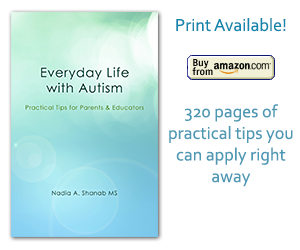Reward and Punishment, Agree or Disagree?
Nadia Shanab | autism, general advice, parenting6 Oct 2012
There are three different schools of thought regarding this matter.
One category of people considers reward and punishment a futile short-term regimen to coach children. They argue that this system fails because it doesn’t teach children good habits, nor puts an end to bad behavior in the long term. This perspective presumes that the effectiveness of a reward or a punishment fades away as soon as they are no longer being applied. According to this hypothesis, human beings are conditioned to be self-motivated to always make the right choices without expecting anything in return. From this standpoint, gratification comes from sheer and pure satisfaction experienced upon meeting expectations. It is natural to feel proud after realizing a goal or overcoming a challenge. But would that be enough of a compensation for hard work?
This particular standpoint makes the assumption that failing to fulfill a requirement would leave the child with a disagreeable feeling that automatically serves as punishment. Do the majority of children possess a level of awareness so high that they are capable of self-assessing their conduct and independently grasp the lesson?
How effective can this strategy really be?
Nonetheless, would human nature decline praise and compliments, or turn down any form of recognition? How does this hypothesis play out in real life? My answer would be in the form of these questions: If your job provides you with a lot of satisfaction, would you still accept to do it for free? Would any student accept a poor GPA after having studied diligently day and night for a whole year? How would you feel if you planted a seed and never saw the flower or the fruit? Why are Olympics’ champions awarded medals?
The second category of people approves of the reward and punishment system under very strict conditions. For example, earning a reward is endowed for outstanding achievements only. This implies that the child’s basic skills and appropriate behavior are taken for granted. Using the same logic, punishment such as removal of a privilege can last for days or even weeks. Is this truly an efficient strategy?
This approach might be effective for High School students, because by that age they may already understand the concept of positive and negative consequences. But what about young children who are just starting to learn about life through new experiences, and are just discovering the civil code for interaction within a community? How about special needs children with ADHD or autism who have a different notion of time, and poor communication and social skills?
The third category of people perceives and uses the reward and punishment system in a more practical and sensible way. Positive and negative consequences complement each other, and should be given wisely to help the child bring forth her/his best performance, which is the ultimate goal.
“No pain no gain” is a proverb that summarizes the essence of this concept.
Here are my thoughts about this seemingly never-ending debatable and unresolved topic. When in doubt, it is safest to refer to basic facts.
1- Life is a give-and-take two-way system, which insures the survival of human beings. Everything happens according to an agreement. If you take care of your body you’ll stay healthy and happy, and if you neglect your health, you’ll suffer and become miserable.
2- Childhood is the golden opportunity to set the stage for a happy life where children can develop confidence and competence. Using consequences will gradually train them to opt for good choices and eventually, the desired conduct will settle forever.
3- Why should we apply consequences? Because children need to know where their boundaries and limits are. It is reassuring to be aware of the lines that are not meant to be crossed.
4- It is crucial for parents and educators to be conscious of the child’s personality, strengths, weaknesses, likes, and dislikes. What might serve as a reward for one child could ironically be another’s child punishment.
5- Consistency is the key to the success of any positive/negative consequence system. Otherwise, this valuable disciplinary tool will lose its effectiveness. It has been proven that, if a behavior is consistently rewarded every time it occurs, it is very likely that this desired behavior will be repeated. Similarly, if an undesired behavior is consistently followed by a negative consequence, this behavior will eventually fade out.
6- No double standards are allowed. In any given setting where children are present, the system should be applied fairly to everyone.
7- Adults should try their best to be creative and come up with engaging and appealing ideas to inspire children and encourage them to cooperate.
8- Based on my belief that humans are born good-natured, I lean towards applying rewards first, as long as they work effectively, until I reach a situation where punishment is the only option left.
9- Make sure the child understands why she is given a consequence, whether positive or negative. Rules should be crystal clear in their mind. Help them connect the dots.
10- Most children with autism have sensory integration issues that might appear to others as misconduct. The lack of eye contact or turning the head away doesn’t necessarily mean that the child is not paying attention. Rocking, flapping hands, spinning, pacing, spacing out, grimacing, squinting, itching, and exhibiting odd gestures are all expressions of discomfort. They indicate that the body and mind are trying hard to retrieve their natural state of neurological balance. It is not about pushing your buttons.
Parents and educators, follow your instinct and innate wisdom. You will be able to find the delicate balance that works to bring the best out of your children.
Nadia Shanab
Find More Tips
Tags: asperger's syndrome, communication, consequences, discipline, flexibility, incentive sticker sheet, rewards, sensory
